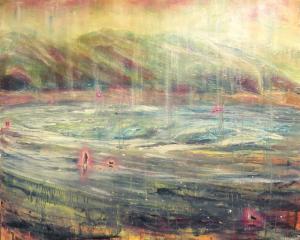Hannah Kidd, "In a Man's World'', Milford Galleries Dunedin
The exhibition as a whole was inspired by the prevalence of masculinity in life on the West Coast. Kidd has expressed her experiences by drawing upon her long-held appreciation for David Attenborough's wildlife documentaries - documentaries which inevitably focus on the "flamboyant male" going to fascinating lengths in order to attract a female mate.
Her assertion is not a feminist proclamation but an observation which is handled with humour and biological curiosity, and it is this distinction which makes her sculptured creatures so unreservedly appealing.
Upon frames of steel rod, Kidd has flattened and recycled old fences, barns and roofs so as to effectively transform masses of ageing tin and corrugated iron into magnificent creatures both great and small.
Her ability to capture the most communicative pose for each animal is truly mesmerising, and the nuances of gesture and gravity have been conveyed with technical and creative skill.
Human personalities are both projected and rejected by these sculptures, while the ascetic gallery environment accentuates their surreality.
Fiona Pardington, "The Pressure of Sunlight Falling", Dunedin Public Art Gallery
The subject-matter solely comprises 19th-century life-casts made by Pierre-Marie Dumoutier during his expeditions in the South Pacific with French explorer Jules Dumont d'Urville.
At a time when people and places still remained uncharted (and with photography not yet invented) accurate documentation was a primary concern.
Dumoutier, as a medical scientist and phrenologist, thus relied on painted plaster positives to provide an appropriately informative record of the people he met while so far from his home. Now, more than 150 years later, Pardington reveals the intimate details that he most carefully recorded.
Each photograph is uniformly enlarged and so every fleshly detail seems to flag the life which formed it - eerily alive, every eyelash a delicate triumph, every crease a vale carved by experience.
We are intensely aware that posthumous casts these are not.
In awe of such breathtaking likeness, we might easily imagine that Pardington has captured entire lives in a single flash. However, as reflection ensues, our tendency to construct, displace and distort cultural memory through representation becomes evident, and we cannot help but think again.
Geoff Williams, "Fragmentum'', The Artist's Room Fine Art Gallery
While he considers drawing to be an essential pre-study for his paintings, he recognises that they are often comprehensive works in their own right, and it is in view of the latter that he presents "Fragmentum" at The Artist's Room.
This exhibition consists of 14 framed drawings from nudes to still-lifes. Each image radiates finesse and textural lucidity and not one piece leaves an unworked trace of the hand which created it.
They are so smoothly rendered and so sensitively handled that the perverse side of the viewer might actually begin to search for flaws, but alas, that search would be in vain.
Daytime TV depicts an elderly man sitting at the edge of his bed, topless, but donning socks, sandals, shorts and cane. Beside him, a modern television sits upon a more cumbersome outdated model, placing old against new, and usefulness against futility.
He is in a pose of deep reflection, and the viewer is compelled to ask why. Williams consistently uses light and reflection to incite contemplation over moments passed.
Through familiar subject-matter he provokes an emotional response and be it flesh or feather, sand or sheet, he offers an infallible feast for the eyes.
- Franky Strachan










![... we all become all of these things [installation view] (2025), by Megan Brady.](https://www.odt.co.nz/sites/default/files/styles/odt_landscape_small_related_stories/public/story/2025/03/1_we_all_become_all_of_thes.jpg?itok=SH-Q8KJZ)
